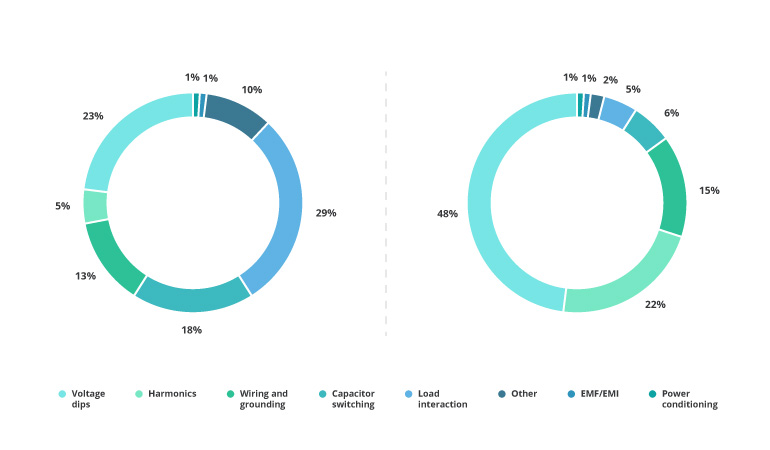A lightbulb is flickering in your office. The computer shuts down when you turn on the fan. Small, everyday disturbances such as these are inconsequential irritations. For large enterprises and industrial plants, however, such power spikes and energy problems are a real nightmare.
The Electric Power Research Institute (EPRI) estimates that industrial facilities in the US lose around $119 to $188 billion annually to downtimes caused by power problems. This is an issue that affects myriad industries — from telecommunications to finance. Voltage sags, swells, and harmonics cause equipment damage, outages, system crashes, and downtime losses for computer networking, semiconductor and electronics manufacturing, biotech labs, data centers, and other businesses.
Fortunately, technology can help mitigate the impact of voltage disturbances and power variations. Industrial businesses implement monitoring solutions to predict energy issues, analyze possible reasons for outages, and protect expensive equipment from damage.
Let’s examine the most common power problems and how companies use technology to avoid them.
In this article, you’ll learn:
- Common types of power quality disturbances
- How energy issues affect industrial businesses
- The definition of power quality monitoring and how monitoring can help to reduce the cost of energy disturbances
- The role of power quality monitoring software
Common types of power quality disturbances

Poor power quality may sometimes go unnoticed at the systems level, but equipment is still affected. Over time, thermal and insulation stress cause malfunctions and early aging of expensive parts, and yet the reasons for degradation aren’t always obvious. Other readily visible power issues cause more extensive damage to equipment and data, and to business overall. Facilities often suffer from the following types of electrical power problems:
- Wiring issues
- Grounding
- Switching transients
- Load variations
- Harmonic generations
Most common power quality problems in the US and Europe

Source: Analog
A full 85% of incidents originate from voltage dips and swells, harmonics, wiring, and grounding issues. Equipment is designed to operate within certain operating conditions. Any power dips and swells can cause system outages and malfunctions. To avoid such problems, some companies have considered alternative sources of energy, such as wind or solar. However, switching power sources has its own issues: harmonics can influence the entire supply network along with transformers and cables.
Specific power quality standards and regulations ensure a common understanding and methodology for quality measurement. These standards help to analyze and monitor data to solve problems and define how a healthy network should look. Quality guidelines are an integral part of power monitoring systems and help to detect any fluctuations from the adopted norms.
How power quality issues affect businesses
Electrical power problems can cause serious economic loss for a company in the following ways:
- Outages cause loss of production or product damage
- Equipment lockup or shutdown interrupts manufacturing
- Data can be corrupted or lost
- Breakdowns of power supplies lead to a reduced lifetime of expensive equipment
Energy waste, loss of revenue, inefficient use of equipment, and loss of data make industrial enterprises adopt various monitoring systems to reduce the effects of poor power quality. Any profit-based operation that is interrupted and has to be restarted incurs economic losses. Add to the equation equipment damage, cost in time for repairs, as well as product damage and the cost to discard equipment or repair it and the economic impact of power quality issues becomes enormous. Under such conditions, risk management is critical.
What’s power quality monitoring, and how can it help?

Power quality monitoring refers to gathering and analyzing measurement data and interpreting it to provide useful business insights. Monitoring systems continuously track voltage and current, and then intelligent systems analyze and interpret raw data with minimum human intervention. An electrical power monitoring system is a complex network of tools (meters), the components of which depend on the monitoring objectives, methods of data gathering and storage, analytics requirements, etc.
What are the reasons for power system monitoring?
- To understand system performance and whether it matches requirements
- To check performance within certain conditions or under certain loads
- To modify the power system
- To perform predictive and timely maintenance
Monitoring systems should be designed based on certain objectives since there are many system conditions that have to be measured, analyzed, and interpreted. Another challenge is the choice of monitoring equipment to cover all the requirements. Do you choose a permanent monitoring solution or portable tools? Which equipment will allow for scaling? How will the system be designed for long-term analysis and statistical data gathering? The combination of devices will depend on your primary goals for power quality monitoring. Generally, intelligent power quality software systems should be able to provide the following insights:
- Which equipment experiences problems
- The nature of the problem
- The time of occurrence
- Which issues follow or coincide with this occurrence
- The possible source of the problem
- Power system data
To cover all these requirements and to add custom ones, companies need an experienced vendor that can develop a comprehensive, user-friendly, and highly autonomous electrical power monitoring system to provide intelligible and timely business insights.
The role of power quality monitoring software

With the development of the Internet of Things (IoT), deploying a network of power quality monitoring devices has become more manageable. Big data analytics and the use of AI allow for more precise predictions and provide real-time information for diagnostics, maintenance, isolation of problems, and more. The challenge is to combine everything into one comprehensive, scalable, and adaptable system.
The task is to integrate data from various IoT devices — analyzers, meters, power quality monitors, etc. — into one complex database with different modules. It should be connected to the geographic information system (GIS), raise various types of alarms, provide automatic reporting, and ensure compliance with standards. It should also make the information easy to access and easy to share. To create such a system, an industrial company needs a highly experienced — and professional — software development vendor.
Conclusion
Power quality analysis is a proactive approach to energy efficiency and equipment maintenance. With the economic impact that electrical disturbances have on industrial facilities, damage control with electrical power monitoring systems is a must for all types of businesses, from electronics to pharmaceutics to finance. Complex power quality software uses IoT programming, AI, and big data to ensure real-time measurement and analysis of a company’s power systems at all levels. With automatic reporting and alarms, stored historical data, and predictive analytics all in place, it is possible — and cost effective — for companies to mitigate the effects of energy problems and to protect expensive equipment from early aging.
If you are looking for a vendor to help build a power quality monitoring system, contact our experts to learn about our practical knowledge of energy distribution solutions.

